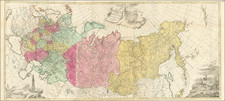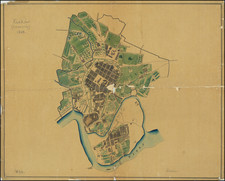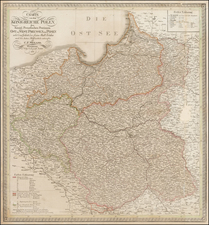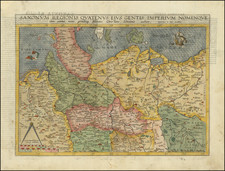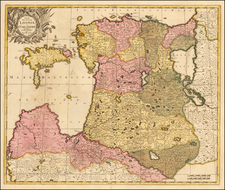Rare early depiction of Prussia (including the northern part of modern Poland and the western part of modern Lithuania).
This 1596 map of Prussia, engraved for Giovanni Botero in Cologne, captures Prussia at a pivotal juncture, delineating a region poised on the cusp of profound political and cultural transformations.
In the late 16th century, Prussia was not yet the unified, powerful state that would later play a pivotal role in European affairs. Instead, it was a patchwork of territories, with major towns like Königsberg (now Kaliningrad), Danzig (Gdańsk), and Elbing (Elbląg) serving as critical hubs of commerce and power under Polish suzerainty.
Botero's map reflects the aftermath of the Livonian War (1558–1583), a protracted conflict involving Poland, Lithuania, Russia, and Sweden, which reshaped the power dynamics in the Baltic region. It was also the era of the Northern Seven Years' War (1563–1570) that left a deep imprint on the area, influencing trade routes and alliances depicted here.
By the time of this map's creation, the influence of the Teutonic Knights had waned, with their secularized domain becoming the Duchy of Prussia under Polish overlordship in 1525. This transition is subtly immortalized in the cartography, where one can infer the gradual shift from a theocratic order to ducal governance.
The map also evokes the cultural and religious transformations of the period, a time when the Protestant Reformation had taken firm root in Prussia, adding another layer to the region's complex identity. The intricate interplay of these major towns with the rural hinterlands offers insights into the socio-economic conditions of the era.
Finally, Botero's work is not merely a geographical record but a historiographical artifact, capturing Prussia before the turbulence of the 17th century, which would see the Thirty Years' War and the eventual rise of Brandenburg-Prussia. This map, therefore, is not just a portrayal of geography but a frozen narrative of a region on the brink of momentous changes, making it an invaluable piece for collectors and historians alike, chronicling an era where the foundations of modern Europe were being laid.









